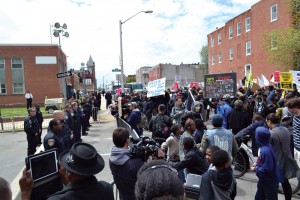Drexel’s James E. Marks Intercultural Center hosted an open discussion for students concerned or distressed by the protests and riots which unfolded April 30 in Baltimore. Since April 20, Baltimore has been in a state of unrest over fatal injuries sustained by Freddie Gray while in police custody April 12 and his subsequent death on April 19. America has been divided and disturbed by this, and so has the student body of Drexel University. Many students voiced concerns over the state of policing in not only Baltimore, but also the nation as a whole. Gray suffered from a severed spinal cord while in police custody and did not receive medical attention until roughly an hour after he was put into a police transport. The conversation continued to relate the events in Baltimore to those in Ferguson, Missouri and to the larger topic of racial tensions in the United States. Two professors were in attendance at this event, Andre Carrington and George Ciccariello-Maher.
Following the Gray incident the city experienced widespread protests. The protests have focused on the alleged misconduct of the police when dealing with Gray and his injuries. Riots broke out throughout West Baltimore April 27; the riots were stopped April 29 following the implementation of a city-wide curfew. Since the end of the riots, the six police officers involved in the incident have been charged with Gray’s death. All six have been charged with misconduct in office, two with assault and improper detention, three with manslaughter and the sixth officer has been charged with second-degree murder.

In an interview with Maher, questions on the state of the timeline of events leading up to the protests in Baltimore were brought into focus. Until recently, the timeline of events surrounding Gray’s death has been widely contested, now several sources, including BBC, CNN and the Baltimore Sun, have released timelines that are in agreement with each other. Maher’s opinion on the ambiguity of the news presented to the public was that “the fact of contestation is in reality, more of a diversion, and an attempt in both [Baltimore and Ferguson] cases to avoid certain troubling realities Mike Brown was shot from a distance, multiple times and while unarmed.”
Following this, the role of conventional media versus social media was discussed. “On the one hand, media have helped by at the very least paying attention to Baltimore — but they only did so after the riots began, and when they arrived, it was often to impose condescending talking points onto the protesters themselves rather than listening to what they had to say,” Maher said. Further clarifying the role of social media he explained, “It’s really only through social media that debates and discussions have seeped into the mainstream. In this case, the traditional media has been uniformly useless.”
Social media has served to engage many people in the issues surrounding Baltimore, police brutality and racial tension. Victoria Durand, a history major, expressed this when interviewed. “I think it’s very important because it’s hard for social media to have the same kind of establishment narrative that more traditional media sources tend to lean toward. In fact, it can expose a side to things that is being deliberately concealed. It’s also fantastic how in fast unfolding situations like protests, the world can be updated on what’s happening in real time,” she said. Another student, who requested to remain anonymous, agreed with this sentiment. “Social media is definitely more important: It allows regular people to spread their opinions much more widely than regular media, which just feature experts,” the student said.
While there was a common sentiment expressed in regard to social media, disagreement began to arise in regard to the police. Durand said, “As a middle class white girl I don’t feel threatened physically by the police on a daily basis, but I don’t see a reason to particularly trust the police either. They’re just a tool of often corrupt localities, with little to stop them from being violent, harmful or just taking advantage of citizens.” Whereas the anonymous source voiced that they “always have a lot of respect for them and their job. I have never really had anything but respect.”
The final statement from Maher was in regard to the rioting.
“If there is a fundamental empirical fact that most observers are overlooking, it’s that riots are incredibly effective in bringing attention to the concerns of the most oppressed, and particularly those lacking the political voice or access to use other means. Many cite the damage caused by riots, but Baltimore was already destroyed by deindustrialization and foreclosures — the damage caused by riots is a drop in the bucket. Riots do not solve the long-term socio-economic questions, but thanks to the riots in Baltimore, Ferguson and elsewhere, these questions are back on the agenda,” Maher explained.
While tensions are still high in Baltimore and throughout the country, a discourse has been opened. Be it through protest or social media, people are able to interact with the issues at hand in a way previously unseen.

